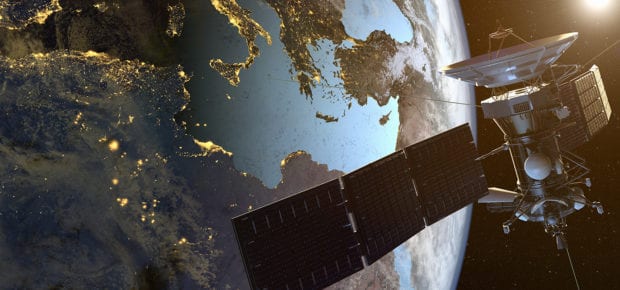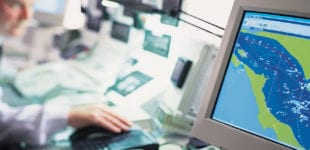August 7, 2019
Earth’s orbit is an increasingly busy place. While there are already about 2,000 satellites circling our planet today, current projections say we could see somewhere around 1,100 new ones launch every year by 2025.
As such, there are a number of emerging technological trends worth investigating, both in terms of software and hardware, that are shaping the role satellites will play in the years to come.
We reached out to two of IEEE’s experts on the subject – IEEE Fellow Marina Ruggieri and IEEE Fellow Adriano Camps – to hear what they see as the biggest developments in the industry, and what we should be on the lookout for.
Software-Defined Satellites
Marina Ruggieri has had a distinguished career, including receiving the honor of being named an IEEE Fellow for her contributions to millimeter wave satellite communications. A telecommunications engineer who has been active in the IEEE Aerospace and Electronic Systems Society for 20 years, she is on the cutting edge of satellite technology.
To Ruggieri, the biggest approaching breakthrough is applying software-defined networking to satellites, which she says represents “a true revolution in the space system realm and in space system design, and something we are going to see in the next year.”
What is software-defined networking, exactly? “It is a change in the layered approach of the network – a new software-driven layer is added on top of the hardware,” says Ruggieri. “The software-defined approach adds flexibility by decoupling the hardware and services, or the hardware and the controls, to a software-based control and software-based encapsulation.”
Why is that important? “In a software-defined network, a human being and a robot can become nodes of the network much easier than in a conventional environment.” This interplanetary network would be much more flexible than the current system, allowing humans and robots to solve unexpected challenges, even across huge distances. In turn, she says, that could “be the difference in countering the effects of climate change and natural disasters, and to guarantee human beings a healthy and sustainable life on earth.”
Getting Smaller
Adriano Camps is the former president of the IEEE Geoscience and Remote Sensing Society. To him, a major development has been the creation of nanosatellites.
“Satellites have become smaller and smaller,” Camps says. “Nowadays there are even private companies running constellations of small satellites (nanosatellites, as they weigh less than 10 kg). Two of these companies have more than 300 and 100 satellites in orbit.”
IEEE Spectrum has covered advances in miniaturizing satellites, as well as the tribulations of getting the Federal Communications Commission (FCC) to approve them – fears of them being too small to track, creating the risk of collisions with other satellites or even manned spacecraft, have caused confusion among those working on them.
New Frontiers of Measurement
Camps has worked on two space missions for the European Space Agency, focusing on soil moisture and ocean salinity (a.k.a. SMOS), and is working on a mission called FSSCat that is scheduled to launch in September.
Soil moisture data can be used to study “desertification, floods and drought studies, forest fire risk evaluation, vegetation senescence El Niño/La Niña events and more,” says Camps. Meanwhile, ocean salinity is used for “circulation, polar caps melting, fisheries, etc. FSSCat data will be used for soil moisture and ice mapping (sea ice extent and thickness).”
Many of these areas are critical to sustainability efforts and to our understanding of how the planet is changing.
The Internet of Satellites
Here on IEEE Transmitter, we’ve covered plenty of developments in applications of the internet of things – agriculture, vehicles, safety, cities. Perhaps unsurprisingly, that paradigm can now be applied to satellites, too.
“AI will help satellites reduce the amount of data to be downloaded, and to download only what is needed, when it is needed,” says Camps. “Together with satellite interconnectivity (or the IoT of Satellites, in plain words), constellations of smaller satellites will be able to alert bigger platforms to acquire more detailed imagery of selected target areas when something’s happening there.”
For more on the future (and past) of satellites, as well as technologies out in space and beneath our oceans, check out our interactive experience Space Exploration, Technology and Our Lives.





 Liquid Infrastructure: Our Planet's Most Precious Resource
Liquid Infrastructure: Our Planet's Most Precious Resource The Impact of Technology in 2025
The Impact of Technology in 2025 Quantum and AI: Safeguards or Threats to Cybersecurity?
Quantum and AI: Safeguards or Threats to Cybersecurity? Why AI Can't Live Without Us
Why AI Can't Live Without Us Bits, Bytes, Buildings and Bridges: Digital-Driven Infrastructure
Bits, Bytes, Buildings and Bridges: Digital-Driven Infrastructure Impact of Technology in 2024
Impact of Technology in 2024 Emerging AI Cybersecurity Challenges and Solutions
Emerging AI Cybersecurity Challenges and Solutions The Skies are Unlimited
The Skies are Unlimited Smart Cities 2030: How Tech is Reshaping Urbanscapes
Smart Cities 2030: How Tech is Reshaping Urbanscapes Impact of Technology 2023
Impact of Technology 2023 Cybersecurity for Life-Changing Innovations
Cybersecurity for Life-Changing Innovations Smarter Wearables Healthier Life
Smarter Wearables Healthier Life Infrastructure In Motion
Infrastructure In Motion The Impact of Tech in 2022 and Beyond
The Impact of Tech in 2022 and Beyond Cybersecurity, Technology and Protecting Our World
Cybersecurity, Technology and Protecting Our World How Technology Helps us Understand Our Health and Wellness
How Technology Helps us Understand Our Health and Wellness The Resilience of Humanity
The Resilience of Humanity Harnessing and Sustaining our Natural Resources
Harnessing and Sustaining our Natural Resources Creating Healthy Spaces Through Technology
Creating Healthy Spaces Through Technology Exceptional Infrastructure Challenges, Technology and Humanity
Exceptional Infrastructure Challenges, Technology and Humanity The Global Impact of IEEE's 802 Standards
The Global Impact of IEEE's 802 Standards Scenes of our Cyber Lives: The Security Threats and Technology Solutions Protecting Us
Scenes of our Cyber Lives: The Security Threats and Technology Solutions Protecting Us How Millennial Parents are Embracing Health and Wellness Technologies for Their Generation Alpha Kids
How Millennial Parents are Embracing Health and Wellness Technologies for Their Generation Alpha Kids Space Exploration, Technology and Our Lives
Space Exploration, Technology and Our Lives Global Innovation and the Environment
Global Innovation and the Environment How Technology, Privacy and Security are Changing Each Other (And Us)
How Technology, Privacy and Security are Changing Each Other (And Us) Find us in booth 31506, LVCC South Hall 3 and experience the Technology Moon Walk
Find us in booth 31506, LVCC South Hall 3 and experience the Technology Moon Walk Virtual and Mixed Reality
Virtual and Mixed Reality How Robots are Improving our Health
How Robots are Improving our Health IEEE Experts and the Robots They are Teaching
IEEE Experts and the Robots They are Teaching See how millennial parents around the world see AI impacting the lives of their tech-infused offspring
See how millennial parents around the world see AI impacting the lives of their tech-infused offspring Take the journey from farm to table and learn how IoT will help us reach the rising demand for food production
Take the journey from farm to table and learn how IoT will help us reach the rising demand for food production Watch technical experts discuss the latest cyber threats
Watch technical experts discuss the latest cyber threats Explore how researchers, teachers, explorers, healthcare and medical professionals use immersive technologies
Explore how researchers, teachers, explorers, healthcare and medical professionals use immersive technologies Follow the timeline to see how Generation AI will be impacted by technology
Follow the timeline to see how Generation AI will be impacted by technology Learn how your IoT data can be used by experiencing a day in a connected life
Learn how your IoT data can be used by experiencing a day in a connected life Listen to technical experts discuss the biggest security threats today
Listen to technical experts discuss the biggest security threats today See how tech has influenced and evolved with the Games
See how tech has influenced and evolved with the Games Enter our virtual home to explore the IoT (Internet of Things) technologies
Enter our virtual home to explore the IoT (Internet of Things) technologies Explore an interactive map showcasing exciting innovations in robotics
Explore an interactive map showcasing exciting innovations in robotics Interactively explore A.I. in recent Hollywood movies
Interactively explore A.I. in recent Hollywood movies Get immersed in technologies that will improve patients' lives
Get immersed in technologies that will improve patients' lives